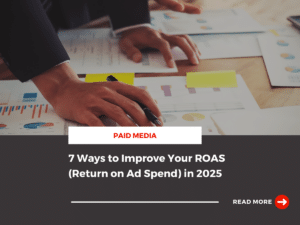For most businesses, advertising is an integral part of their marketing strategy. These paid opportunities allow you to expand your reach to new markets and retarget your products and services to your current customers.
But are your ads truly delivering results?
When did you last take a step back and analyze the return on investment for your campaigns? Are your PPC ads on Google or social media platforms worth monthly or daily spending?
The only way to know this is by tracking your return on ad spend (ROAS).
Marketing professionals use ROAS to measure the effectiveness of their campaigns and ensure they are allocating their budgets wisely. In this guide, we’ll walk you through everything you need to know to improve your ROAS and get more out of your advertising strategy.
Let’s dive in.
What is ROAS?
ROAS (Return on Ad Spend) is a marketing metric that shows how much revenue is generated for every dollar you spend on a paid campaign.
You can use ROAS to evaluate the success of your entire advertising strategy or drill down to specific campaigns, platforms, or targeting methods.
Example: If you run a campaign that generates $4,000 in revenue and costs $2,000, your ROAS is 2. This means for every $1 spent, you earned $2 in revenue — a solid return!
As a general rule of thumb:
- A ROAS of 2 or above is considered good.
- Aim for a ROAS of 3 or 4 for optimal results.
How To Calculate ROAS
Just like other marketing key performance indicators, ROAS can be calculated using a simple formula. Many advertising platforms will show you your ROAS for a specific campaign on their platform. However, if you want to take a broad approach, you’ll want to use the formula below.
ROAS = (attributed revenue from ads/cost of ads)
Let’s break it down:
Let’s say you’re running an ad campaign that generates $4,000, and you invested $2,000 into the advertising campaign. If you plug these numbers into the formula, you’d get a 2. For every $1 you spent, you gained $2 in revenue – which is pretty great!
This formula is a great tool to help you keep a pulse on the success of your advertising strategy as a whole, especially if you’re using more than a few advertising platforms.
As a general rule of thumb: A good ROAS is anything above a 2. While the average ROAS for businesses is a 2, you should always aim for a 3 or a 4.
ROAS vs. ROI
While ROAS and ROI may seem similar, they serve different purposes:
- ROAS is a quick indicator of advertising success.
- ROI evaluates the overall return after all business expenses are accounted for.
| Metric | Focus | When to Use |
|---|---|---|
| ROAS | Advertising spend and performance | Short-term campaign evaluation |
| ROI | Overall business profitability | Long-term business strategy |
Ways To Improve ROAS
1. Google Performance Max Campaigns
Google Performance Max campaigns automate your ad strategy by using AI to optimize performance. Provide Google with your targets, assets, and budget, and it will create a goal-based campaign to boost conversions.
Tip: This is particularly useful if you’re new to Google Ads or your campaigns aren’t delivering results.
2. Leverage Negative Keywords
Negative keywords exclude irrelevant search terms in PPC campaigns, helping you refine your targeting and avoid wasted spend.
Example: If you sell luxury watches, you might exclude “cheap watches” as a negative keyword.
3. Optimize Your Ads For Mobile
Over 50% of internet traffic comes from mobile devices. Ensure your:
- Ad creatives are mobile-friendly.
- Landing pages load quickly and are easy to navigate on smartphones.
Neglecting mobile optimization can harm your CRO, ROAS, and ROI.
4. Create Custom Landing Pages for Your Ads
Generic homepages can hurt your ROAS. Instead, create dedicated landing pages tailored to each campaign.
Key Elements for Custom Landing Pages:
- Clear headline matching your ad.
- Compelling copy.
- Strong call-to-action (CTA).
- Minimal distractions.
5. Use Geotargeting
Geotargeting is a great tool that can help you target an audience in a particular area. Whether you have an event in a location or a service for a city: using location-specific targeting will help you get more from your ad spend.
Example: If your service is limited to New York City, use geotargeting to exclude audiences from neighboring areas.
6. Monitor Conversion Rate Optimization (CRO)
CRO and ROAS go hand in hand. If you’re getting clicks but aren’t seeing sales, you’ll want to rethink your conversion rate optimization strategy and look for ways to get shoppers to complete their purchases.
Clicks without conversions mean wasted spend. Improve your CRO by:
- Abandoned Cart Emails: Recover potential sales.
- Discounts/Free Shipping: Incentivize purchases.
- Chatbots: Offer real-time assistance.
- Exit Pop-ups: Provide last-minute offers.
7. Time Your Campaigns Strategically
You won’t always see the results you want if you only focus on evergreen content or standard advertising creatives. By tailoring your content to align with special events, seasons, holidays, and limited-time offers, you can create a sense of urgency that will push your customers to purchase.
Align campaigns with:
- Holidays and events.
- Seasonal trends.
- Limited-time offers.
Tip: Compare ROAS for time-sensitive campaigns vs. evergreen ones to refine your strategy.
Get to Your Target ROAS With Kanbar Digital
If you want to maximize your advertising investment, you need a data-driven strategy. Whether it’s Google Ads, Facebook, or another platform, Kanbar Digital can help you identify new opportunities and optimize your campaigns.




